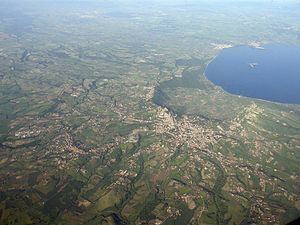Elevation 800 m | Easiest route walk Last eruption 104 BC Province Province of Viterbo | |
 | ||
Similar Roccamonfina, Monti Sabatini, Porak, Sousaki volcano, Göllü Dağ | ||
Vulsini, also known as Volsini volcano, Vulsini Volcanic District, Vulsini Volcanic Complex and the Vulsinian District, is a circular region of intrusive igneous rock in Lazio, Italy, about 87 km (54 mi) to the north northwest of Rome, containing a cluster of calderas known to have been active in recent geologic and historical times. Potentially they still are active. The Vulsinian region is one of dozens of intrusive circular regions, most smaller than the Vulsinian, arranged in a band from Campania through Lazio, called the Roman Comagmatic Province. A comagmatic province is a geologic area of the same type and age igneous rock deriving from the same crustal magma. The Roman region is post-collisional; that is, the intrusions were not a result of the lateral stresses that created Italy and raised the Apennines, but were subsequent to Italy's creation. The Volsinian is the northernmost region.
Contents
Map of Vulsini, 01010 Gradoli, Province of Viterbo, Italy
At relatively low altitude, the Vulsini calderas cover about 2,280 km2 (880 sq mi) and contain four Pleistocene-age depressions known as Bolsena, Latera, Vepe and Montefascione calderas. The latest activity occurred in 104 BC. The largest, the Bolsena caldera, which is roughly 16 km (9.9 mi) across, is filled with the waters of Lake Bolsena, which derive mainly from deep aquifers. Immediately to the northwest are the combined Latera and Vepe calderas, about 8 km (5.0 mi) by 11 km (6.8 mi). Vepe, to the north of Lake Mezzano (a very small crater lake west of Lake Bolsena) is what is known as a nested caldera; it arose in the previously existing Latera Caldera. Italian routes SS74 and SS312 follow the rim from Valentano through Latera westward, turning off before Mezzano on the other side. In addition the small Montefiascone caldera, also nested, lies between Montefiascone on its eastern rim and the lake. Two islands in the lake, Bisentina and Martana, were formed from airfall tuffs in Pompeii-like eruptions. Dozens of other tuff cones dot the region, mainly on the eastern side of the complex.
SubfeaturesEdit
The following tuff cones stand out in the region:
